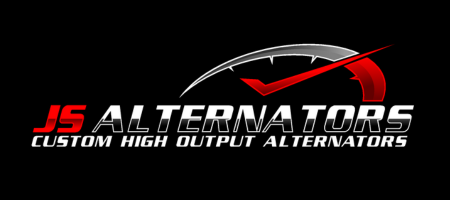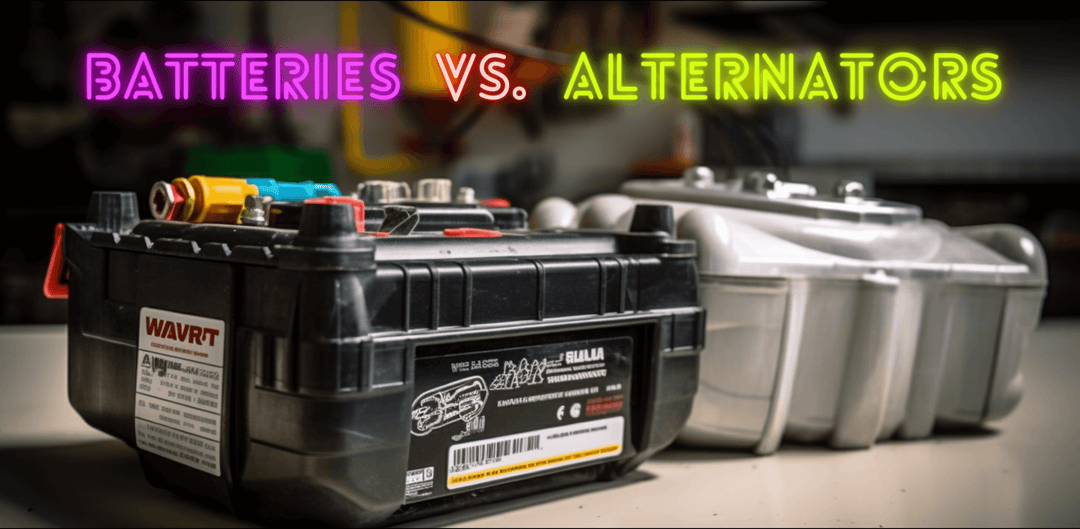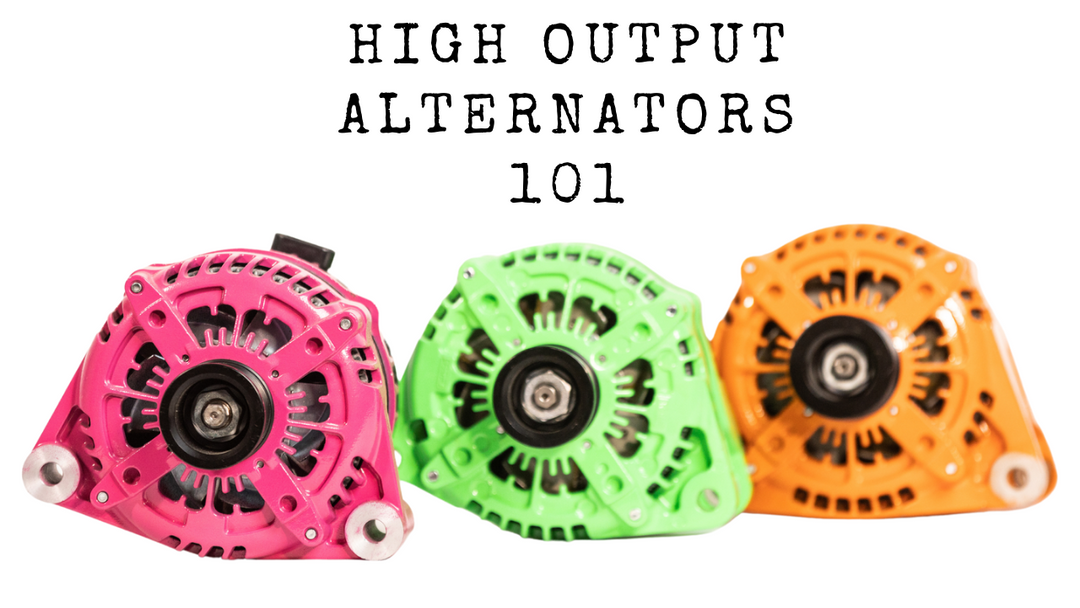High Output Alternators 101: A Comprehensive Guide to High Output Alternators
As automotive technology continues to progress, the demand for electrical power in modern vehicles has grown exponentially. High-performance sound systems, LED lighting, and other aftermarket accessories necessitate a reliable and efficient source of electrical energy. For this reason, upgrading to a high output alternator is becoming increasingly popular among car enthusiasts, as it offers a practical solution to the increased power requirements.
This article explores the importance of performance and high output alternators, factors to consider when upgrading, and the key signs that indicate it’s time for an upgrade, ultimately guiding the reader in determining the necessity and suitability of a high output alternator for their vehicle.
Firstly, a comprehensive understanding of the basic components and functions of an alternator is essential in order to make an informed decision regarding an upgrade. This article will delve into the intricacies of high output alternators, discussing their differences from OEM-stock alternators, and outlining the various types of pulleys available. Additionally, the article will provide insight into which vehicles most commonly require a high output alternator, allowing the reader to better assess their own vehicle’s needs.
Following this foundational understanding, the article will present five key signs that indicate a need for an upgrade or replacement of the vehicle’s alternator to a high output alternator, offering practical guidance for those seeking to enhance their vehicle’s electrical capabilities.
What Is a High Output Alternator?
Understanding the functionality and potential benefits of a high-output alternator is crucial when considering modifications for enhanced vehicular performance and power management.
A high-output alternator is an electrical generator that is capable of producing more amps across the board than a stock unit, thus providing a higher amount of electrical energy to power various vehicle functions and charge the battery.
This type of alternator is essential for vehicles with upgraded audio systems, additional lighting, or other power-demanding modifications, as it ensures a constant and sufficient supply of electrical energy to support these functions without overloading the factory alternator.
When deciding whether to upgrade or replace a vehicle’s alternator with a high-output version, it is important to consider the additional power requirements that come with any modifications or upgrades.
Installing powerful audio components, for example, can quickly overload a factory alternator, leading to early failure and potential damage to other electrical components.
In such cases, a high-output alternator may be necessary to accommodate the increased demand for electrical energy.
Additionally, it is essential to ensure that the correct gauge wire is used to handle the increased amperage output, as well as to make any necessary modifications to power and ground cables to prevent potential issues related to overheating or burning.
Parts of The Alternator
The pulley, an integral component of the alternator, spins using the vehicle’s belt system and works in conjunction with the stator, which consists of tightly wound copper bundles.
The rectifier, composed of diodes, transforms the alternating current (AC) produced by the spinning rotor within the stator into direct current (DC), which is used to charge the car’s battery.
Additionally, the voltage regulator, connected to the rectifier, functions as a surge protector ensuring that the charging system maintains an acceptable range, while the housing serves as a protective casing, encompassing the internal components and mounting the alternator to the vehicle.
Pulley
A critical component of an alternator is the pulley, which plays a significant role in determining its efficiency and performance. The pulley is responsible for transmitting mechanical energy from the engine to the alternator, enabling the conversion of this energy into electrical power for the vehicle’s charging system.
High output alternators, designed to handle increased power demands from upgraded audio systems or other aftermarket modifications, often feature an improved pulley design that allows for better power transmission and overall efficiency. When considering an alternator upgrade, it is essential to evaluate the pulley’s quality and compatibility with the vehicle’s engine and belt system to ensure optimal performance.
The pulley’s size and design can also impact the alternator’s output and overall efficiency. Smaller pulleys can generate higher output at lower engine speeds, making them ideal for vehicles with high electrical demands at idle or low engine speeds. Conversely, larger pulleys may be more suitable for vehicles that operate at higher engine speeds, where the increased surface area can provide better grip and power transmission.
Additionally, some high output alternators may feature overdrive or underdrive pulleys to optimize the charging system’s performance for specific applications. Ultimately, selecting the appropriate pulley for an alternator upgrade is crucial to maximizing the benefits of high output alternators and ensuring a reliable and efficient charging system.
Stator
Stator design plays a significant role in the efficiency and performance of an alternator, as it is responsible for generating the magnetic field that induces electrical current within the alternator’s rotor. The stator is composed of a series of copper wire windings that are precisely wound around an iron core.
The quality, size, and number of these windings can significantly impact the output capabilities of the alternator, making the stator a critical component in determining whether a high output alternator is necessary to replace a vehicle’s existing alternator.
There are three key factors to consider when evaluating the need for a high output alternator based on stator design:
- The number of windings: A high output alternator typically has more windings than a standard alternator, allowing it to generate a higher current output.
- Wire gauge: The thickness of the copper wire used in the windings can also influence the stator’s efficiency. High output alternators often utilize thicker wire, which can handle higher current loads without overheating.
- Core material: The type and quality of the iron core can affect the stator’s ability to generate a strong magnetic field, with higher quality materials resulting in better performance.
If any of these factors are insufficient in a vehicle’s existing alternator, it may be necessary to upgrade to a high output alternator in order to meet the demands of upgraded electrical systems or to improve overall vehicle performance.
Rectifier (Diodes)
Efficient rectification of alternating current into direct current is crucial for optimal performance of a car’s electrical system, and rectifiers, composed of diodes, play a vital role in this process. In a high output alternator, the rectifier is designed to handle higher amperage loads and maintain a stable voltage output, ensuring that the various electrical components in the vehicle receive adequate and steady power. Typically with a higher output alternator, like JS Alternators, they come with a 6-phase hairpin stator which requires upgrading the rectifier to handle the higher capacity diode increase.
| Component | Function | Importance in High Output Alternator |
|---|---|---|
| Rectifier | Converts alternating current (AC) into direct current (DC) | Ensures stable voltage output |
| Diodes | Semiconductors that allow current to flow in one direction | Handles higher amperage loads |
| High Output Upgrade | Increases the capacity of the alternator for higher demands | Improves efficiency and reliability |
When upgrading to a high output alternator, it’s important to consider the quality and capacity of the rectifier and its diodes to ensure that the new alternator can handle the increased electrical demands of the vehicle. A high-quality rectifier with robust diodes can make a significant difference in the performance and longevity of the alternator, reducing the risk of premature failure and ensuring that the vehicle’s electrical components receive a consistent and reliable supply of power. In conclusion, considering the rectifier and diodes is an essential aspect of upgrading to a high output alternator, and investing in a quality upgrade can enhance the overall performance and reliability of the vehicle’s electrical system.
Voltage Regulator (plug)
The voltage regulator, often found as an integrated component within the alternator or as a separate unit, plays a critical role in maintaining a consistent voltage level for the vehicle’s electrical system, ensuring optimal performance and preventing damage to sensitive components.
When upgrading to a high output alternator, it is essential to ensure that the voltage regulator is compatible with the new alternator in terms of capacity and performance. A mismatch between the voltage regulator and the high output alternator can lead to voltage fluctuations, decreased performance, and potential damage to the electrical system.
In some cases, the voltage regulator may need to be upgraded or replaced along with the vehicle’s alternator to accommodate the increased power output from a high output alternator. This is particularly important for vehicles with significant aftermarket electrical modifications, such as high-end audio systems, additional lighting, or other power-demanding components.
By upgrading the voltage regulator alongside the high output alternator, vehicle owners can ensure that their electrical system operates smoothly and efficiently, providing reliable power to all components without overloading or damaging the system.
Housing
Moving on from the voltage regulator, another essential component of a high output alternator is the housing. The housing is the structural element that contains all the internal components of the alternator, protecting them from external factors and ensuring proper thermal management.
When considering upgrading or replacing your vehicle’s alternator to a high output alternator, it is crucial to assess the quality and suitability of the housing design. The housing of a high output alternator should meet specific criteria to ensure its efficiency and longevity.
Here are four key aspects to consider when evaluating the housing of a potential upgrade or replacement:
- Material: The housing should be made of a durable and heat-resistant material, such as aluminum or high-grade steel, to withstand the increased power output and heat generation associated with high output alternators.
- Ventilation: Proper ventilation is essential for maintaining the optimal operating temperature of the alternator. The housing should have strategically placed vents or openings to facilitate airflow and prevent overheating.
- Mounting: The housing should be compatible with your vehicle’s existing mounting points and hardware, making the upgrade or replacement process straightforward and minimizing the need for additional modifications.
- Finish: A high-quality finish, such as powder coating or anodizing, can help protect the housing from corrosion and other environmental factors, prolonging its service life and maintaining its appearance.
In conclusion, the housing plays a vital role in the performance and durability of a high output alternator. By considering the material, ventilation, mounting compatibility, and finish, you can make an informed decision when upgrading or replacing your vehicle’s alternator with a high output alternator that meets your specific needs and requirements.
OEM-Stock Alternators Vs. JS Alternators High Output Alternator
A comprehensive comparison between OEM-stock alternators and JS Alternators high output alternators can help vehicle owners make informed decisions when considering upgrades or replacements.
OEM-stock alternators are typically equipped with a 3-phase slot wound stator and use a standard OEM pulley. The rectifier in OEM-stock alternators has 3-6 diodes, and the rotor has a lower amp rating.
On the other hand, JS Alternators high output alternators are designed with a 6-phase hairpin stator, a smaller pulley that increases spin ratio, and a rectifier with 12 diodes. Additionally, JS Alternators feature a higher amp rotor with an internal cooling fan.
Some key differences between OEM-stock alternators and JS Alternators high output alternators include:
- Stator design: OEM alternators use a 3-phase slot wound stator, while JS Alternators use a 6-phase hairpin stator.
- Pulley size: JS Alternators have a smaller pulley than OEM, resulting in a faster spin ratio and requiring a shorter belt.
- Diodes on the rectifier: OEM alternators have 3-6 diodes, while JS Alternators feature 12 diodes.
- Amp rating of the rotor: JS Alternators have a higher amp rotor compared to OEM alternators.
- Cooling system: JS Alternators high output alternators are equipped with an internal cooling fan, which is absent in OEM alternators.
When deciding whether to upgrade the alternator in a vehicle, it is essential to consider the specific requirements of the electrical system and the benefits of a high output alternator. JS Alternators provide increased performance and reliability, making them an ideal choice for vehicles with high electrical demands, such as those with powerful car audio systems or various aftermarket accessories.
Different Types of Pulleys
In the realm of high output alternators, there are various types of pulleys that can be utilized for different applications, including Serpentine Pulleys, V-Belt Pulleys, and Double V-Belt Pulleys.
Serpentine Pulleys, characterized by their flat and wide design, use a single continuous belt that snakes around multiple pulleys, resulting in improved efficiency and reduced slippage.
On the other hand, V-Belt Pulleys, which consist of a V-shaped groove, and Double V-Belt Pulleys, which have two separate V-shaped grooves, provide a more traditional and time-tested approach for transmitting power between the alternator and other engine components.
Serpentine Pulleys
Serpentine pulleys play a crucial role in the efficient functioning of an automobile’s electrical system, and their condition can greatly impact the overall performance of the vehicle.
These pulleys are specifically designed to work with high output alternators, ensuring that the vehicle’s alternator is able to produce the necessary electrical power to support various components, such as the engine, air conditioning, and other accessories.
When upgrading or replacing a vehicle’s alternator with a high output alternator, it is essential to also consider the condition and compatibility of the serpentine pulleys, as they play a central role in the transfer of mechanical energy to electrical energy.
Upgrading to high output alternators often requires the use of serpentine pulleys that are capable of handling the increased power demands of the upgraded electrical system.
These pulleys are designed to provide improved efficiency and reduced slippage, ensuring that the vehicle’s alternator is able to generate the required electrical power without straining the engine or other components.
In cases where the existing serpentine pulleys are worn or incompatible with the new high output alternator, it may be necessary to replace or upgrade them to ensure optimal performance and longevity of the vehicle’s electrical system.
Failure to address this crucial component could lead to unnecessary strain on the engine, reduced performance, and potential damage to the high output alternator.
V-Belt Pulleys
V-belt pulleys, another essential component in an automobile’s electrical system, require careful consideration when upgrading to a more powerful alternator. These pulleys, which are designed for use with v-belts, are responsible for transferring mechanical energy from the engine to the alternator, enabling it to generate the electrical power needed to run various systems in the vehicle.
When upgrading to high output alternators, it is crucial to ensure that the v-belt pulleys are compatible with the new alternator, as improper compatibility can lead to decreased performance, premature wear, and other issues.
When selecting v-belt pulleys for use with high output alternators, there are a few key factors to consider:
- Size and fit: It is essential to choose a pulley that is the correct size and fit for both the upgraded alternator and the existing v-belt. This is necessary to ensure proper alignment and tension, which will help prevent slippage, belt wear, and other issues related to belt misalignment.
- Material: V-belt pulleys can be made from various materials, including cast iron, steel, and aluminum. Each material has its own advantages and disadvantages in terms of weight, durability, and heat resistance. When upgrading to a high output alternator, it may be worth considering a pulley made from a more heat-resistant material to help manage the increased heat generated by the larger alternator.
In conclusion, upgrading to high output alternators necessitates careful examination of the compatibility and suitability of v-belt pulleys. Ensuring proper size, fit, and material selection will not only help maximize the performance and longevity of the upgraded vehicle’s alternator but also contribute to the overall efficiency and reliability of the automobile’s electrical system.
Double V-Belt Pulleys
Double v-belt pulleys, an essential component in certain automobile electrical systems, warrant attention when considering a more powerful alternator, as these components are responsible for effectively transferring mechanical energy from the engine to the alternator, ensuring optimal performance and efficiency. When upgrading to high output alternators, it is crucial to assess the compatibility of double v-belt pulleys with the new alternator, as an improper fit or misaligned pulley can lead to premature wear and tear on the belts, reduced alternator output, and even potential damage to the vehicle’s electrical system.
| High Output Alternators | Upgrade Considerations | Double V-Belt Pulleys |
|---|---|---|
| Increased power output | Proper fit | Optimal alignment |
| Enhanced efficiency | Belt compatibility | Correct belt tension |
| Better performance | Pulley material | Quality of components |
| Suitable for upgrades | Sufficient belt length | Proper belt sizing |
When selecting double v-belt pulleys for high output alternators, it is essential to consider factors such as the proper fit, belt compatibility, pulley material, and the quality of components in order to ensure that the upgraded vehicle’s alternator operates at its maximum potential. Proper alignment, correct belt tension, and sufficient belt length are also crucial in maintaining the longevity and performance of the double v-belt pulley system. By paying close attention to these factors, car enthusiasts can confidently upgrade their vehicle’s alternator to a high output alternator, ensuring optimal performance and efficiency for their upgraded electrical system.
Conclusion
In conclusion, upgrading to a high output alternator is essential for vehicle owners who have implemented performance modifications or added power-hungry accessories. Ensuring the vehicle’s electrical system can handle the increased demand not only improves performance but also prevents potential damage to the battery and other electrical components.
By recognizing the signs that indicate the need for a high output alternator and understanding various aspects such as OEM-stock vs JS alternators and types of pulleys, one can make an informed decision for their vehicle.
This knowledge is crucial in maintaining the overall health and performance of the vehicle’s electrical system.












